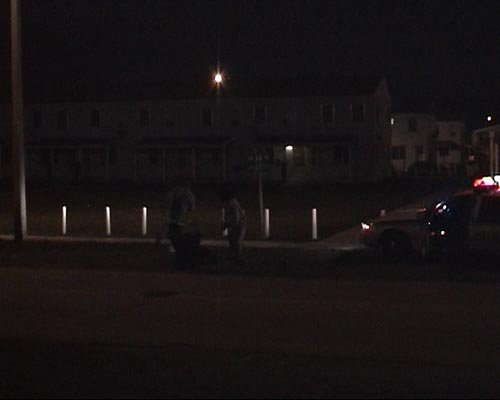Peter Friedl
dal 10/3/2008 al 18/4/2008
Segnalato da
10/3/2008
Peter Friedl
Galleria Meyer Kainer, Wien
In his first solo exhibition at Galerie artist presents work that explores the photographic gaze the relationship between document and artifact in different ways. The work addresses questions of originality and historicity and how these give rise to new pictures. As the art of observation, every theory draws a picture of the world.

Exhibitions by Berlin-based Austrian artist Peter Friedl (b. 1960) are rarely seen in Vienna. In his first solo exhibition at Galerie Meyer & Kainer he presents work that explores the photographic gaze—the relationship between document and artifact—in different ways.
No Photography (2004) refers to the political division of Cyprus, but in a broader sense to the question “What is a border?” and thereby also to the history of other divisions. The frame around the context-less plasma screen places a border around a quiet, innocuous scene, in which white clouds slowly drift from left to right across a blue sky, a border which recalls the classic picture, while at the same time going far beyond. Friedl in fact photographed real clouds in the sky over the no-photography zone of the “Green Line” that has divided Cyprus for decades. The cloud images were then animated in the studio. The computer animation was originally part of the larger exhibition project OUT OF THE SHADOWS, realized by the artist at the Witte de With, center for contemporary art, in Rotterdam. The less realistic the moving clouds appear, the clearer their function as a means of aesthetic reflection, for example, on art’s ability to be political. Cultural historian Mieke Bal writes, “No Photography appears to ask the question how far you can, must go, beyond contextualism.”
Pictures from newspapers and magazines, which Peter Friedl has been collecting and exhibiting since 1992 for his archive project Theory of Justice, are also the subject of the series of black and white photographs (2006-2008), presented here for first time. The work addresses questions of originality and historicity—and how these give rise to new pictures. As the art of observation, every theory draws a picture of the world. But what happens if the images themselves want to become theory? The title refers to the attempt at renewing social contract theory undertaken by the American philosopher John Rawls (1921–2002).
A Theory of Justice (1971) and the subsequent restatement Justice as Fairness are classic examples of a political liberalism that believes in the possibility of a well-ordered society and the overarching consensus of its members. But when the global drama of the present is one of exclusion and marginalization, such theories of justice and distribution are out of touch with reality. In grasping instead the logic of the political as opposition to the logic of the administrative, of police repression, and institutional regulation, conflict (resistance) takes the place of consensus. The small shadows at the periphery of these use-images, re-photographed with black-and-white negative film, transform history into temporary autonomy.
In his new video Liberty City (2007), Peter Friedl addresses another standard historical scene. On the night of 17 December 1979, the (black) motorcyclist Arthur McDuffie was stopped by (white) cops on the corner of North Miami Avenue and 38th Street and beaten to death. When the accused policemen were acquitted five months later, Liberty City exploded. It was the darkest moment in the history of Miami. Desolate Liberty City haunts voyeuristic reality TV series in emulation of Homicide. Friedl inverts the dramatic structure: In the scene staged and filmed on site, the (white) cop is the victim. The film was shot in the streets of the Liberty Square Housing Project, a residential complex built during the Roosevelt era in the 1930s for African-American residents.
To keep the black and white populations separated, a wall was erected on the eastern boundary of Liberty Square, the remains of which can still be seen today. Friedl’s short, uncut loop is a tribute to the community of Liberty City—epic theatre in the genre of documentary aesthetics.Peter Friedl’s work has been exhibited worldwide, including documenta X (1997) and documenta 12 (2007), the 48th Venice Biennale (1999), the 3rd Berlin Biennale (2004) and the 2nd International Biennial of Contemporary Art in Seville (2006). His work is represented in major international collections such as the Centre Pompidou, Paris; Walker Art Center, Minneapolis; Museu d’Art Contemporani de Barcelona; The Margulies Collection, Miami; the Hamburger Kunsthalle and the upcoming new Museum of Modern and Contemporary Art Bolzano.
Selected solo exhibitions:
Künstlerhaus Bethanien, Berlin (1996); LACE, Los Angeles (1998); Palais des Beaux-Arts, Brussels (1998); Neuer Berliner Kunstverein, Berlin (1999); Living Art Museum, Reykjavik (1999); Casino Luxembourg , Luxembourg (2001); Chisenhale Gallery, London (2001); Institut d'art contemporain, Villeurbanne-Lyon (2002); Institute for Contemporary Art, Cape Town (2002); Society for Contemporary Art, Bremen (2002); Frankfurter Kunstverein Frankfurt am Main (2004); Witte de With, center for contemporary art, Rotterdam (2004); Midway Contemporary Art, Minneapolis (2006). In 2006 the Museu d’Art Contemporani de Barcelona (MACBA) organized a comprehensive retrospective, which was subsequently taken over by Miami Art Central/Miami Art Museum and the Musée d'art contemporain in Marseilles. The exhibition Working remains on view at the Kunsthalle Basel through 30 March 2008. Peter Friedl has been nominated for the Vincent Award 2008 in Amsterdam.
Opening: Tuesday, 11 March 2008, 7 pm
Galleria Meyer Kainer
Eschenbachgasse 9, Wien
free admission



